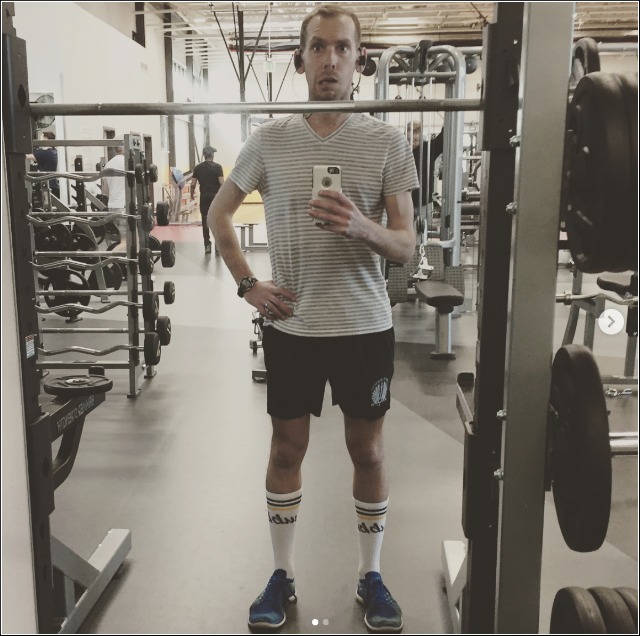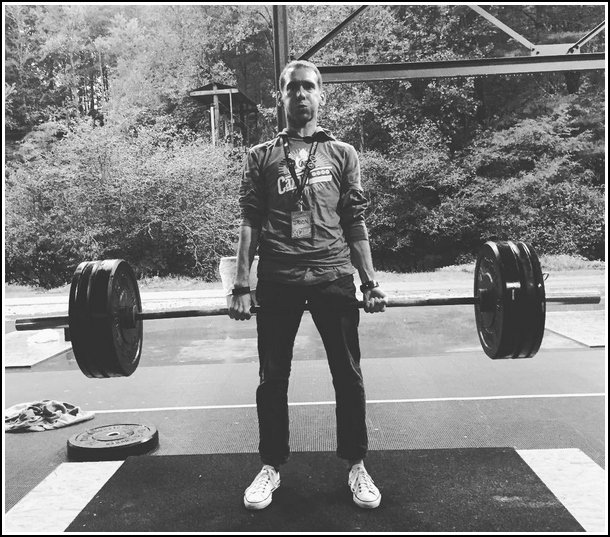Did you know that I used to think weight training was useless for runners? I mistakenly believed we needed no strength training whatsoever…

Runners at the gym are funny. Embrace it!
Of course, I was completely wrong.
I didn’t understand beginner weight training – or anything about weightlifting! This mistake led me to adopt strength training slowly in college as I was resistant to the workouts prescribed by our coaches.
The result? I got hurt all the time!
It wasn’t until I was injured for 6 months with IT Band Syndrome that I finally got serious about strength training. For the first time, I was consistently working on getting stronger.
And the results were powerful:
- In 10 years, I only had one major injury
- My marathon PR improved by 5+ minutes to 2:39:32
- I won a Warrior Dash obstacle course race, a small marathon, and a half marathon
Over time, I came to recognize weight training for runners as necessary. It’s not a “nice to do” but a “must do” for any runner who wants to achieve their potential.
As I sat down with strength experts and world-class coaches for the Strength Running Podcast, it became clear that strength training is mandatory.
It’s not cross-training, just part of the training runners must do.
To ensure runners were lifting properly, I hired a USA Weightlifting National Coach to develop a progressive, periodized, runner-specific weight training program.
The result is High Performance Lifting, the only strength program built by both a USA Track & Field certified coach and USA Weightlifting National Coach. It quickly became one of our most popular programs.
But it had an interesting side effect…
Beginner Weight Training Fears

This is not as heavy as it looks because I’m not actually very strong
One of the most fascinating consequences of this new program is that I receive a lot of questions about whether runners are ready to begin weight training.
And it seems that many runners – like me years ago – have quite a few reservations about lifting weights.
Many of us think that bodyweight strength training is enough. While that’s great – it will get you far – it’s far from ideal.
And the questions I receive demonstrate the fear we have around lifting weights:
- “I can’t squat or lunge… is this program for me?”
- “How do I know if I have enough mobility for weight training?”
- “Won’t I get hurt lifting heavy weights at the gym?”
First, let’s ignore the fact that running is essentially a series of coordinated, single-leg squats. If you can’t squat, you probably shouldn’t be running much.
These are the same runners who train for marathons, run hill workouts, sprint, and cover dozens of miles every week.
The riskiest thing to do is not lift weights! Running itself (the workouts, long runs, and repetitive nature of high mileage) is decidedly more risky than lifting weights a few times per week.
Most runners have enough general fitness, mobility, and strength to begin a beginner weight training program. The hesitations that one might get injured or lack the flexibility to start lifting are almost entirely unfounded.
It’s not a lack of mobility or ability that’s holding runners back in the weight room, it’s the fear of doing something outside of our comfort zones.
Mobility Training = Training

Many runners mistakenly believe that they must undergo drastic preparation to get into the weight room.
They think they must be extraordinarily flexible and have the mobility of an Olympic steeplechaser. Because if you can’t move like a gymnast, how in the world can you ever squat or deadlift?!
The truth is that lifting is not much different from running. They both require mobility and if you’ve been training soundly, you’re already mobile enough for beginner weight training.
Just think of all the activities that runners do that boost our mobility:
- Hill workouts (running against gravity at fast speeds requires power)
- Trail running (you need more mobility to run technical terrain)
- Sprinting (running fast demands larger ranges of motion)
- Dynamic warm-ups (this is exactly mobility training)
- Using a foam roller (enhanced blood flow and relaxation promote mobility)
- Cross-training (moving through different ranges of motion enhances movement fluency)
- Form drills (i.e., exaggerated running form movements)
- Strength training (moving differently than running improves athleticism)
These workouts, drills, and recovery strategies require you to move differently than if you were running slowly on even terrain. Those larger and varied ranges of motion all maintain your mobility.
Plus, you gain strength from many of these activities, helping you stay coordinated, athletic, and powerful.
When these are all included in a sound training program, mobility is worked on daily without ever worrying too much about it.
So if you think you need to devote a lot of time to “mobility” just remember that sound training IS mobility training.
Mobility for Weight Training
Runners need adequate hip and ankle mobility to start a beginner weight training program. Thankfully, if you’ve been training appropriately (like we talk about in the section above), you likely already have a high degree of mobility.
All those form drills, hill workouts, trail runs, foam rolling, cross-training, and sprinting makes you into quite a mobile athlete.
But the specific mobility required will come more from actual strength training. The “sandwiching” approach that is a core of my coaching philosophy helps you with much of the preparatory work needed before you ever step foot inside a weight room.
Strength Running’s collection of dynamic warm-ups, strength workouts, and core routines are ideal mobility training for the squat because they force you to move in even wider ranges of motion.
The exercises in the strength routines here include:
- 6 different types of lunges
- 11 different types of planks
- Single leg squats
- 5 different types of bodyweight squats
- 2 types of step-up exercises
- And so many more…
By engaging in a variety of movements throughout your training (often with 20+ different exercises every day), you’re already ready to start a weightlifting program.
You have the general fitness, the general strength, and the mobility to engage in big lifts in the gym.
How Do We Ensure Mobility in HPL?
While I firmly believe most runners are ready to start a weight training program, if you’ve never set foot in a gym it can be intimidating.
First, we’re not used to lifting next to CrossFitters, football players, and people who seem to know what they’re doing. Doing something silly makes us feel embarrassed in front of these athletes.
And if you’re like me, wearing your split-leg shorts in the gym is an invitation to criticism (I say bring it on!).
Ultimately, we can ensure you’re mobile enough to lift properly in several ways:
- Have a foundation of training already built before you start weight training
- Complete a lifting-specific mobility screen before starting
- Lift with proper technique
- Don’t lift too much weight (and even if you do, know how to abandon a lift)
Most runners have #1 already covered. Dynamic warm-ups, core workouts, bodyweight strength routines, form drills, sprinting, and hill workouts all build your foundation. If you’re training well, you’re ready.
But once you get into the weight room, we must focus more on #2 – #4.
That’s why in High Performance Lifting, we do all three. We use a mobility screen to identify any red flags in your mobility and then ensure that you have proper form by having two elite runners demonstrate every movement with two different camera angles.
But the biggest issue is when runners try to lift weights that are too heavy. Any mobility problem will be compounded and exposed by lifting more weight than you’re ready for (just like injury risks are magnified when you run hard or very long).
The great news is that runners don’t have to focus too much on how much weight they’re lifting.
Instead, focus on gradually adding weight and perfecting the movements.
Remember, we’re training our coordination under resistance. We’re building coordination and efficient movement patterns – not just trying to get stronger
Beginners: How to Start Weight Training
If you’ve been thinking about lifting weights but you weren’t sure where to start, I hope this article has given you permission to believe that you can get into the weight room and lift!
Weight training is for endurance runners. It’s helpful, more approachable than you think, and is something that you can start today.
If you haven’t yet, start sandwiching your runs. That practice alone will ensure you’re ready for the gym in just a month or two.
But if you have already built a solid foundation of fitness and strength with bodyweight strength exercises, faster workouts, dynamic warm-ups, and strides, then you’re ready to get into the weight room.
Sign up here for our free series on strength training for endurance runners. You’ll learn:
- The most common weightlifting mistakes that runners make
- Form, strength, power, and injury prevention benefits you can expect to experience
- Example exercises that demonstrate how to lift for power and speed
- Case studies of other runners just like you who’ve had massive transformations
Besides “proper training,” adding weightlifting to your schedule is likely the most impactful strategy you can implement to improve.
Get started here and let’s see what your’e capable of achieving as a runner.